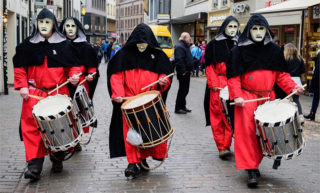Brahms vs Bruckner
Sinfonieorchester Basel
27 and 28 September 2017
Vadim Gluzman, Violin
Ivor Bolton, Conductor
Cristóbal Halffter - Alucinaciones. Collage para trio basso y orquesta
Johannes Brahms - Concert for violin and orchestra
Anton Bruckner - Mass No. 3 in F Minor
“Ahh, Brahms… Everybody loves Brahms”, she said with a roll of the eyes. She had been hoping to hear a more surprising name. But on his first date with his wife-to-be, my composer friend couldn’t deny it was Brahms he loved most. Brahms always had a great following, and the violin concerto, on tonight’s program, is one of his most popular pieces.
How different that was for Bruckner (1824–1896). During his life Bruckner received less appreciation than the slightly younger Brahms (1833–1897). “Interminable, disorganised and violent” were words used for his 8th symphony by a contemporary critic. The Nazi’s veneration of Bruckner’s music didn’t help its reception in later times. To this day, people tend to think about Bruckner in terms of black and white. You love him or you hate him. Nonetheless, his symphonies and masses are now a part of the musical canon.
This concert combines two pieces that were conceived at roughly the same stage in the careers of the aforementioned composers. The violin concerto was premiered in 1879 when Brahms was 45; the 3rd mass had its first performance in 1872, Bruckner being 47.
The juxtaposition of Brahms and Bruckner is interesting for several reasons. In his days Bruckner was pitted against Brahms as a Wagnerian symphonist for the avantgarde. Brahms was the standard-bearer of the Bach-Mozart-Beethoven line. There are also striking parallels: two lifelong bachelors, they each enjoyed a steep career, which eventually took both men to Vienna. However, while Brahms surrounded himself with friends and acquaintances, Bruckner complained at several occasions about his loneliness.
The violin concerto was composed for Joseph Joachim, a Hungarian violinist and friend of Brahms. As such, it is not a surprise the concerto features Hungarian rhythms. Brahms’s disposition for Hungarian folk music was stirred up earlier in life when, as adolescent, he played with the Hungarian violinist Ede Reményi. Hamburg, at the time, counted many Roma who prepared for their passage to America.
The concerto has the same key (D major) as the Beethoven concerto, giving rise to the idea that Brahms was inspired by it. Both concertos were received with mixed reviews for the same reason: too hard to play. Written “against the violin”, were the infamous words about the Brahms piece. De Sarasate allegedly refused to play the piece because of the prominent oboe solo in the second movement, but Joachim respected the beautiful contrast between the violin and the oboe.
Bruckner’s 3rd Mass in F minor underwent many revisions, something for which he was generally criticized. Just as the violin concerto makes a nod to Beethoven’s, Bruckner’s mass was influenced by Liszt’s Gran Mass. The piece is a so-called ordinary mass, meaning there are no sung texts for special occasions, such as an Offertorium (placing bread and wine on the altar) or Communion (distribution of wine and bread).
Despite being set against one another by the public, there was no animosity between the two composers. Brahms is said to have applauded Bruckner’s 3rd Mass very enthusiastically. Ahh, Bruckner…!
These English Program Notes have been published in the magazine of the Sinfonieorchester Basel (No.2, 2017/2018)








Comments